I realize I'm joining the Final Cut Pro X conversation a little late in the game, but I tend to give things the benefit of the doubt, and honestly, I was a bit shocked and confused by what I was hearing regarding the new, download-only, "app" release. This New York Times article helps shed some light on the hysterical rants of the FCP community by pointing out some of the favorite features from FCP 7 which are just in different places in FCP X, and explaining how some features will be added later on. It's an article definitely worth reading.
Currently, I'm not too worried about Final Cut Pro X. As the article accurately points out, we're not yet obligated to upgrade, and FCP 7 is still working just as well as it ever did. My concern is where Apple is going to be taking FCP X in the future. If the future of Final Cut Pro is to become "iMovie Pro" then I will have to start shopping for and learning a new platform, like Avid or Adobe. However, I'm not ready to count FCP X out yet. I think Apple and Mr. Jobs have something up their sleeve.
Here's what I think is really going on. The FCP X which we have seen and been gossiping about is Apple's new entry level editing software. Within a relatively short time span, iMovie will unexist like in Orwell's 1984. Apple computers will come with absolutely no video post software OR a new program which will be more or less unusable. All home movie enthusiasts, and amateur film makers will have to cough up $300.00 to play Spielberg in their backyards.
What about the Pro level users you ask? The FCP X I speak of will act as the foundation for which Pro Level editors can begin to build a proper post platform. After downloading some upgrades and spending money on additional "apps", pluggins, 3rd part software/hardware, a Pro Editor will actually have built himself a Final Cut Pro X editing station which basically resembles a FCP 7 platform, but it will be able to background render and allows editing while ingesting media. FCP X will the Lego set of None Linear Editors, allowing users to add functionality and compatibility as they see fit.
I could just be in denial; the release of Final Cut X could be the end of pro level editing platforms from Apple, but what I've described above seems like a logical business model. Apple is a pretty sharp company, and I really can't believe they would just throw themselves under the bus. Why would they spend so many years building a pro level piece of software, as well as a faithful following, just to throw it all out?
What do you all think?
Thursday, July 7, 2011
Thursday, June 2, 2011
Been Really Busy
Hey people of the interwebs. I know it's been a while since my last post, but I've been pretty busy working on things ranging from script rewrites, to shooting, to editing, and lighting... and the list goes on and on. I'm going to try my best to catch up and post about all the exciting things that have been going on. For those who were following my post about using an FiiO headphone amp to boost mic volume while disabling the ACG on your  camera, I have finally shot all of the footage I need for the blog, and I'll be putting that together shortly. I appreciate your patients.
camera, I have finally shot all of the footage I need for the blog, and I'll be putting that together shortly. I appreciate your patients.
About a month ago, Andrew Bellware gave me a part in his upcoming feature film, currently title "Android Insurrection" Before I go into details about the part, I should tell you about Mr. Bellware. He created a small indy production company called Pandora Machine. Specializing in scifi genre type movies, Pandora Machine is a one stop production house which cranks out between 2 and 3 movies a year, and SELLS THEM!!!! The movies are a blast to make, and Drew as taught me countless things about making movies, which is why I never hesitate to lend a hand. This brings me to the part I played in the movie.
While going through the script to work out some kinks, I found a character; Mooney, who had no lines, dies within the first few pages, and had a Big Friggin Gun. I figured I could get my shots done in one day, leaving plenty of time to help out on set, and I could easily make a kick ass prop gun for my character. It turns out that the only day of production I was able to make it for was the one I was acting in, and that BFG which I thought was going to be cheap and easy to make... ended up being a handful. However those are tales best left for another day. Here are some pictures from the last day of principle photography on the Pandora Machine film, Android Insurrection.
Here is the Great Profit Bellware telling all us actors what the heck to do.
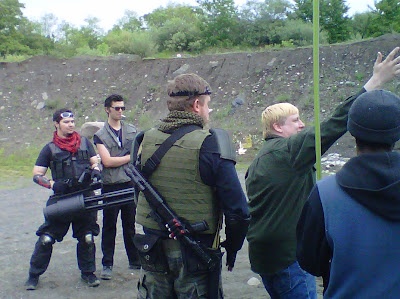
here Drew realizes that any and all efforts to direct this heard of cats is futile, so he just walks off sets
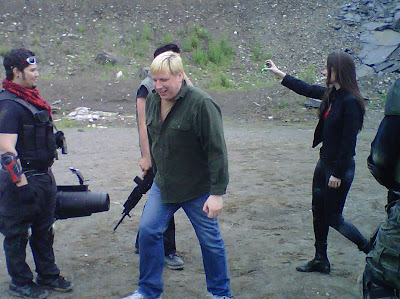
We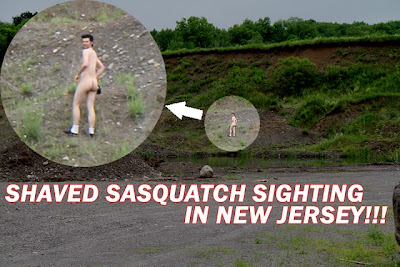 saw this crazy looking thing running through the location.
saw this crazy looking thing running through the location.
Getting ready to roll cameras and shoot the next take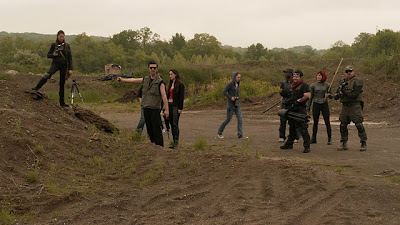
I found this in a pile of dirt while shooting

Post Apacalytic Death Squad
Gotta keep it cool
Getting some fight direction before being killed by an android
This poor boom op had his work cut out for him
Raining dow hell fire on some robot suckers




 camera, I have finally shot all of the footage I need for the blog, and I'll be putting that together shortly. I appreciate your patients.
camera, I have finally shot all of the footage I need for the blog, and I'll be putting that together shortly. I appreciate your patients.About a month ago, Andrew Bellware gave me a part in his upcoming feature film, currently title "Android Insurrection" Before I go into details about the part, I should tell you about Mr. Bellware. He created a small indy production company called Pandora Machine. Specializing in scifi genre type movies, Pandora Machine is a one stop production house which cranks out between 2 and 3 movies a year, and SELLS THEM!!!! The movies are a blast to make, and Drew as taught me countless things about making movies, which is why I never hesitate to lend a hand. This brings me to the part I played in the movie.
While going through the script to work out some kinks, I found a character; Mooney, who had no lines, dies within the first few pages, and had a Big Friggin Gun. I figured I could get my shots done in one day, leaving plenty of time to help out on set, and I could easily make a kick ass prop gun for my character. It turns out that the only day of production I was able to make it for was the one I was acting in, and that BFG which I thought was going to be cheap and easy to make... ended up being a handful. However those are tales best left for another day. Here are some pictures from the last day of principle photography on the Pandora Machine film, Android Insurrection.
Here is the Great Profit Bellware telling all us actors what the heck to do.

here Drew realizes that any and all efforts to direct this heard of cats is futile, so he just walks off sets

We
 saw this crazy looking thing running through the location.
saw this crazy looking thing running through the location.Getting ready to roll cameras and shoot the next take

I found this in a pile of dirt while shooting

Post Apacalytic Death Squad

Gotta keep it cool

Getting some fight direction before being killed by an android

This poor boom op had his work cut out for him

Raining dow hell fire on some robot suckers




Tuesday, March 8, 2011
Camera Slider and Crane/Jib All In One
My Facebook friend Giulio Sciorio tagged me in a post this afternoon. To my surprise, the video below is what I found.
I think the people at Floatcam really have an interesting take on the camera/jib combination. Kessler Crane has products which offer similar functionality, but they are quite a bit bulkier and not always easy to set up on the fly.
I haven't been able to find much information about the Floatcam Dollycrane but I am willing to wager some guesses based on the above video. The rails are probably made of aluminum and look very similar to the Igus DIY sliders. The rubber wheels look a lot like the Pegasus Cable Wheels sold by Cinevate and the counter balance system reminds me of the one on the Cinevate Atlas 10, except the Atlas 10 counter balance only worked for vertical operation
(I think). The mount for the slider is pretty unique in design, but seems to function like most tripod/camera slider mounts. There's also a clip in the video that leads me to believe there will be a hand crank or motor option for this production and if not, one should be pretty easy to fashion DIY style.
I can't find an exact price for this, but Giulio heard rumors of $4500 on Cinema 5D. I'm not sure what that price will include, but it could be a really good option for someone who hasn't already invested in a slider or jib.
Thanks for sharing the video Giulio.
If anyone has any more information on this product, please drop me an email, or leave something in the comments below.
I think the people at Floatcam really have an interesting take on the camera/jib combination. Kessler Crane has products which offer similar functionality, but they are quite a bit bulkier and not always easy to set up on the fly.
I haven't been able to find much information about the Floatcam Dollycrane but I am willing to wager some guesses based on the above video. The rails are probably made of aluminum and look very similar to the Igus DIY sliders. The rubber wheels look a lot like the Pegasus Cable Wheels sold by Cinevate and the counter balance system reminds me of the one on the Cinevate Atlas 10, except the Atlas 10 counter balance only worked for vertical operation
(I think). The mount for the slider is pretty unique in design, but seems to function like most tripod/camera slider mounts. There's also a clip in the video that leads me to believe there will be a hand crank or motor option for this production and if not, one should be pretty easy to fashion DIY style.
I can't find an exact price for this, but Giulio heard rumors of $4500 on Cinema 5D. I'm not sure what that price will include, but it could be a really good option for someone who hasn't already invested in a slider or jib.
Thanks for sharing the video Giulio.
If anyone has any more information on this product, please drop me an email, or leave something in the comments below.
Labels:
A.,
Cinematographer,
crane,
David,
director,
DSLRs,
Editor,
FCP,
Frey,
Guy,
jib,
Photographer,
Productions,
slider
Saturday, February 26, 2011
Disable AGC and Monitor Audio on Your Canon T2i
While this method has been effective at reducing the noise caused by the AGC, it has also reduced the overall recording volume of the camera, which is a problem when working with soft spoken talent. When I ran into this problem, I was at a bit of a loss for a way to fix it. I emailed Deejay of DSLRfilmnoob.com, and after much thought, he suggested using a headphone amplifier to boost the volume of the mic heading into the camera, kind of like a preamp. What a genius idea!
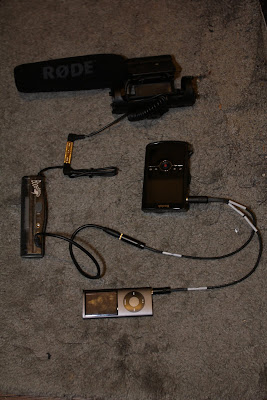
I did some searching on the interwebs, and found many different types of headphone amps, at many different prices. The Boostaroo Headphone Amp was on the cheaper side, could be found at any Radio Shack, and would output amplified audio to 3 devices. Since it had 3 output jacks, I could send one into the camera, and plug a headset into another. Below is an example of how I attached the headphone amplifier to my camera. The Kodak Zi8 stood in for my T2i since I was using it to take the photo.

To explain: the Rode Video Mic is connected to one end of a 1/8 female to 1/8 female coupler. The input of the Boostaroo Headphone Amp is plugged into the other end of the coupler. In the first output of the Boostaroo is a 1/8 male to 1/8 male audio cable which connects to the mic input of the Sescom Cable. My MP3 player is plugged into the AGC Disable end of the Sescom Cable, and this is all connected to the External Mic jack on my "T2i".
It's not shown in the above image, but you can add a pair of headphones to the Boostaroo and monitor the audio before it reaches the camera. It should be noted that the ideal place to monitor audio is when it's been passed through the camera, however, because of the constant tone played by the MP3 player to disable the AGC, you would only hear noise in your headset. If however you have a DSLR with manual audio controls, and an external monitor, check out Deejay's headphone hack.
While the Boostaroo did increase the gain of the microphone in my tests, it only increased it by 10-15db which didn't make a significant difference. The Boostaroo also lacks any type of volume control, it's either on or off, and when it's off, it decreases the recording volume and introduces a lot of noise. Finally, the Boostaroo ended up being much larger and heavier then I anticipated.
Although I will be returning the Boostaroo, it did prove proof of concept, so in it's place I have ordered the Micca Fiio e5. This unit is much smaller and lighter, has volume control, is rechargeable, has a much higher output power then the Boostaroo, is cheaper then the Boostaroo, and can often be purchased with a Y splitter like the package I linked to above. With the Y splitter you can add your headset and still be able to monitor the audio.
When the Micca Fiio e5 shows up I'll put together a video showing how I set it all up, and I'll include some tests.
Labels:
A.,
Affordable,
AGC Disable,
Audio,
Canon Rebe T2i/550D,
David,
Frey,
Greenwich Village Cinematographer,
Guy,
Monitor,
Productions
Friday, January 7, 2011
More Time Lapse Tests
Happy Belated Holidays, and I hope the New Year is off to a good start for everyone. It's been a while since my last post, but I've had a lot of little projects in the works, and now they will start trickling in to the blog.
Today I want to continue discussing time lapse photography. To be honest, I'm still a bit mystified by time lapse, and based on some of the experts at Timescapes.org, it's no wonder. Although there is a lot which can be learned about shooting time lapse, getting that beautiful sequence relies, in large on luck. The members of the Timescapes.org forum have some great information up, but I've decided to continue shooting more tests with my T2I.
I've been comparing the different automatic modes on the camera, to figure out their best applications. Below is a video comparing the Av mode with the Tv mode. Neither of these clips have any color correction or de-blinking applied, they are straight out of the camera.
Av Mode: So Av mode is the cameras aperture priority mode. You set the desired aperture, and the camera automatically adjusts all other settings like shutter speed. The down side to using Av mode is it can make for an inconsistent time lapse. Look at the first clip, there are some sections where the lights on the cars are nice and streaked (there was less light in the shot so a lower shutter speed was used) and some shots where you can make out distinct details on the cars (there was a lot of light in the shot, so a faster shutter speed was used). The advantage to Av mode is it's ability to define your depth of field. If you were to shoot a time lapse of the sky, this is less of an issue since your lens will be focused to infinity, but if you have objects in the foreground and background, you will want to lock your aperture, otherwise you will see the focus change from shot to shot.
Tv Mode: Tv mode allows you to set the shutter speed, and automatically adjust the other elements, such as aperture to properly expose each shot. The plus to Tv mode is it allows you to have consist ant motion capture from shot to shot. Look at the second clip, the cars passing by the church all have that beautiful streaked look, except for the ones which got stuck at the light. Tv mode in my mind captures the essence of time lapse by allowing you to control how motion will be perceived in your final video. The down side to Tv mode is the automatic changing of aperture. If your lens isn't set to infinite, you will see the focus and depth of field shift between shots, which is really annoying. However, I've had no complaints shooting extremely wide shots, or sky shots in Tv mode.
Comparison and Other Thoughts: In comparing the two different modes in the above video, the blinking seems much more apparent in when using Av Mode. Although it's possible that nights conditions contributed to the blinking, the two streets had similar lighting and traffic flow. Although you can still notice the blinking in the street lights in the Tv mode clip, it's much more subtle.
Tv mode has become one of my favorite auto settings when shooting at an infinite focus point. Av mode would be useful if I were keeping one particular object in focus through out a time lapse, but I'm just not crazy about the change in motion captures. I find it distracting to see images go from streaky to clearly defined. However, which mode you use will depend on the effect your looking for and the circumstances under which your shooting.
Today I want to continue discussing time lapse photography. To be honest, I'm still a bit mystified by time lapse, and based on some of the experts at Timescapes.org, it's no wonder. Although there is a lot which can be learned about shooting time lapse, getting that beautiful sequence relies, in large on luck. The members of the Timescapes.org forum have some great information up, but I've decided to continue shooting more tests with my T2I.
I've been comparing the different automatic modes on the camera, to figure out their best applications. Below is a video comparing the Av mode with the Tv mode. Neither of these clips have any color correction or de-blinking applied, they are straight out of the camera.
Av Mode: So Av mode is the cameras aperture priority mode. You set the desired aperture, and the camera automatically adjusts all other settings like shutter speed. The down side to using Av mode is it can make for an inconsistent time lapse. Look at the first clip, there are some sections where the lights on the cars are nice and streaked (there was less light in the shot so a lower shutter speed was used) and some shots where you can make out distinct details on the cars (there was a lot of light in the shot, so a faster shutter speed was used). The advantage to Av mode is it's ability to define your depth of field. If you were to shoot a time lapse of the sky, this is less of an issue since your lens will be focused to infinity, but if you have objects in the foreground and background, you will want to lock your aperture, otherwise you will see the focus change from shot to shot.
Tv Mode: Tv mode allows you to set the shutter speed, and automatically adjust the other elements, such as aperture to properly expose each shot. The plus to Tv mode is it allows you to have consist ant motion capture from shot to shot. Look at the second clip, the cars passing by the church all have that beautiful streaked look, except for the ones which got stuck at the light. Tv mode in my mind captures the essence of time lapse by allowing you to control how motion will be perceived in your final video. The down side to Tv mode is the automatic changing of aperture. If your lens isn't set to infinite, you will see the focus and depth of field shift between shots, which is really annoying. However, I've had no complaints shooting extremely wide shots, or sky shots in Tv mode.
Comparison and Other Thoughts: In comparing the two different modes in the above video, the blinking seems much more apparent in when using Av Mode. Although it's possible that nights conditions contributed to the blinking, the two streets had similar lighting and traffic flow. Although you can still notice the blinking in the street lights in the Tv mode clip, it's much more subtle.
Tv mode has become one of my favorite auto settings when shooting at an infinite focus point. Av mode would be useful if I were keeping one particular object in focus through out a time lapse, but I'm just not crazy about the change in motion captures. I find it distracting to see images go from streaky to clearly defined. However, which mode you use will depend on the effect your looking for and the circumstances under which your shooting.
Tuesday, November 9, 2010
PBS' Circus Documentary
About two years ago, I picked up a part time gig working as a Logger for Show Of Force; a small production company who exceled in making award winning documentaries. The project I was working on has now been release. Circus follows the life of the performers and crew of the Big Apple Circus for a season as they tour the East Coast.
I realize this post is a little late, as the show primered on November 3rd, but have no fear, you can catch up on what you missed by checking out video clips of Circus on PBS' website. The next episode is on November 10th (tomorrow) and I'm really excited to see what this episode has in store.
Working as a logger can be a little boring, especially on a documentary. There are literally thousands of hours of footage which need to be viewed, broken up, and carefully labeled in order for the editors to be able to find footage easily. Some of the footage is great, but some is repetative. I can't even remember how many times I've seen the Big Top tent being put together. However, there are some good things about logging.
1.) you get to see all of the behind the scenes footage which may not even make it to the special features section on a DVD.
2.) you get to try and figure out which story the final show will follow.
and the Bonus benefit:
3.) You know the back story behind what's happening in the show, and you can share it with your friends and family. It's a dorky bonus, but it's fun.
I realize this post is a little late, as the show primered on November 3rd, but have no fear, you can catch up on what you missed by checking out video clips of Circus on PBS' website. The next episode is on November 10th (tomorrow) and I'm really excited to see what this episode has in store.
Working as a logger can be a little boring, especially on a documentary. There are literally thousands of hours of footage which need to be viewed, broken up, and carefully labeled in order for the editors to be able to find footage easily. Some of the footage is great, but some is repetative. I can't even remember how many times I've seen the Big Top tent being put together. However, there are some good things about logging.
1.) you get to see all of the behind the scenes footage which may not even make it to the special features section on a DVD.
2.) you get to try and figure out which story the final show will follow.
and the Bonus benefit:
3.) You know the back story behind what's happening in the show, and you can share it with your friends and family. It's a dorky bonus, but it's fun.
Labels:
Affordable,
Circus,
David A. Frey,
DP,
Final Cut Pro,
Greenwich Village Cinematographer,
Guy,
music,
PBS,
Photographer,
Productions
Thursday, October 28, 2010
DIY Shoulder Rig For $80 and Hoodman Loupe Modification Tutorial
Recently, IndieBudgetMovie left a very nice comment on my youtube video illustrating how to modify a Hoodman Loupe using a Delkin Pop-Up Shade so it can be attached directly to the LCD on your DSLR. If you haven't seen my Hoodman Modification Tutorial, and aren't happy with your LCD view finder and how it attaches, check out the tutorial above.
In any case, it turns out IndiBudgetMovie is a master of DIY as well, and put together this awesome video showing off an adjustable shoulder rig he made for $80 using a drywall square. What's great about this build is that it can easily be adjusted to fit many different types of shooters and styles. I've seen a lot of shoulder stabilizers built from PVC, which works well, unfortunately, once all the parts are connected, it can't be easily adjusted. This rig looks very solid, and not to difficult to build.
Combined with the Modified Hoodman Loupe, this will look like a pretty professional rig, and will be very functional. IndieBudgetMovie says he's going to try out my modification, so maybe he'll put together a follow up video. I'd be excited to see someone else using the modded Hoodman Loupe.
To date, this makes two people I know of who have used my tutorial to ditch the rubberbands, and secure their view finders in a better way.
I'm glad to see other people benefitting from it. After all, that's why I made the video in the first place.
In any case, it turns out IndiBudgetMovie is a master of DIY as well, and put together this awesome video showing off an adjustable shoulder rig he made for $80 using a drywall square. What's great about this build is that it can easily be adjusted to fit many different types of shooters and styles. I've seen a lot of shoulder stabilizers built from PVC, which works well, unfortunately, once all the parts are connected, it can't be easily adjusted. This rig looks very solid, and not to difficult to build.
Combined with the Modified Hoodman Loupe, this will look like a pretty professional rig, and will be very functional. IndieBudgetMovie says he's going to try out my modification, so maybe he'll put together a follow up video. I'd be excited to see someone else using the modded Hoodman Loupe.
To date, this makes two people I know of who have used my tutorial to ditch the rubberbands, and secure their view finders in a better way.
I'm glad to see other people benefitting from it. After all, that's why I made the video in the first place.
Labels:
A.,
Affordable,
City,
David,
DIY,
DP,
Editor,
FCP Editor,
Frey,
Greenwich Village Cinematographer,
Guy,
Hoodman,
Loupe,
music,
Photographer,
Productions,
Special Events Video,
Video
Subscribe to:
Comments (Atom)



